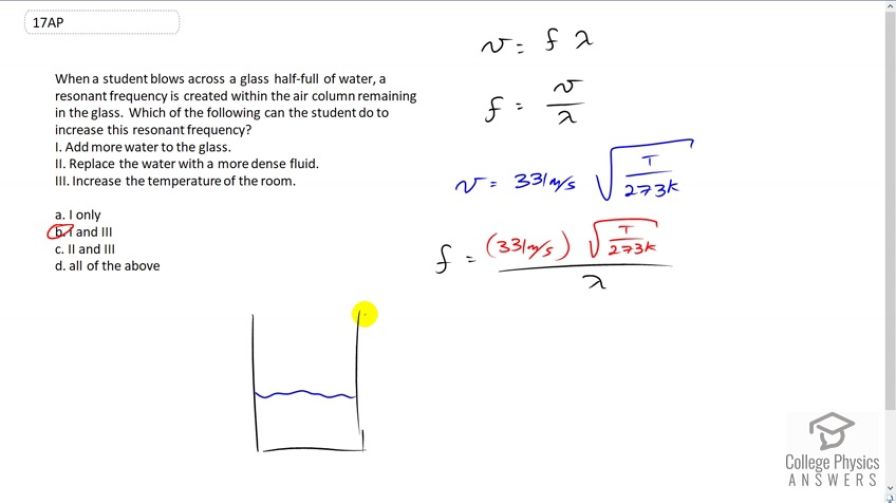Question
When a student blows across a glass half-full of water, a resonant frequency is created within the air column remaining in the glass. Which of the following can the student do to increase this resonant frequency?
- Add more water to the glass.
- Replace the water with a more dense fluid.
- Increase the temperature of the room.
- I only
- I and III
- II and III
- all of the above
Final Answer
(b)
Solution video
OpenStax College Physics for AP® Courses, Chapter 17, Problem 17 (Test Prep for AP® Courses)

vote with a rating of
votes with an average rating of
.
Video Transcript
This is College Physics Answers with Shaun Dychko. The student is blowing air across the opening of a glass which has some water some distance below the top of the glass and that's going to cause a resonant frequency inside the glass with a wavelength equal to the resonant. The fundamental, anyhow will have a wavelength equal to four times this distance between the top and the water level. Because this is a quarter of a wavelength fitting within this length, and so that means the wavelength is four times L. Now, if this L is decreased, that's going to decrease the wavelength. And frequency is the speed of sound divided by the wavelength. So as we increase or as we decrease lambda, as we decrease the denominator of this fraction, we will be increasing the quotient. We will be increasing the frequency in other words. So, lower wavelengths correspond to higher frequencies. So as you increase the water level, you're going to decrease the wavelength and thereby, increase the frequency. So, one works. Three also works because since frequency is the speed of sound divided lambda, if we can change the speed of the sound we can change the frequency. And the speed of sound in air is 331 meters per second times square root of the temperature divided by 273. And so when we substitute that and see this frequency formula, we can see that as T increases, so does F. And so three also works, although it is going to make only probably a small effect but it does work. In the previous question we saw that a person who play the wind instrument increase the temperature from ten degrees to 30 degrees Celsius. This results in a frequency change of a 0.3 percent which is the minimum that we can perceive. And number two, replace the water with a more dense fluid does not change anything because the sound is not going through the water, the sound is in the air above. And it bounces off. This surface is just the same whether it is a densed water or not densed water or fluid. So two does not work. So the answer is b, one and three only.